The flowering perennial plant marticaria (Matricaria), which is also called chamomile, is a representative of the Asteraceae family. This genus unites about 20 species. The most popular among them is pharmacy chamomile, which is widely used for medicinal and cosmetic purposes. Under natural conditions, this plant can be found in South Africa, Eurasia and America, while it was also introduced to Australia. Chamomiles are also called plants of other genera, similar to marticaria, belonging to the Astrov family, for example: pupavka, gerbera, doronicum, feverfew, daisy and aster. The fact is that all these plants form inflorescences-baskets during flowering. For such a plant, the scientific name was derived from the Latin word, which means "uterus", this is due to the fact that chamomile has long been used to treat gynecological diseases. The Russian name was borrowed from the Polish language, while it is considered to be derived from the word romana translated as "Roman", this is due to the fact that in the 16th century marticaria was called "Roman color".
Content
Features of marticaria
Marticaria is a not very tall herbaceous perennial. The composition of the pinnately dissected leaf plates includes many small lobes. The scutes consist of hemispherical inflorescences-baskets, reaching 0.4–2 centimeters across. Such baskets are formed by bisexual tubular flowers of yellow color, which are collected in the middle in a disk, and also by pistillate false reed - they are painted white and frame the disk. The fruit is achene. Such a culture has a not very strong, but specific smell, its pollination occurs at the expense of bees or wasps. Seed material remains viable for 3 years.
Growing matricaria from seeds
Sowing seedlings
Experts advise that decorative varieties of marticaria should be grown exclusively through seedlings. Sowing is carried out in March or April. To do this, the containers or boxes are filled with a loose, light, moist and nutritious soil mixture, on the surface of which seeds are distributed, while a distance of 20–30 mm must be kept between them. They are buried in the substrate only 10 mm. Moisten crops from a spray bottle and cover them on top with glass (transparent film). Transfer containers to a bright and warm place. It is easy to take care of the crops, they need to be systematically ventilated, the accumulated condensate removed from the shelter and, if necessary, moisten the surface of the soil mixture.
Seedling care
Immediately after the first seedlings appear, the shelter is removed from the container, and it is moved to a cool place, because in the warmth the plants will stretch. Seedlings also need to provide a large amount of bright light, but it must be diffused. The pick is carried out after the second true leaf plate begins to form in the plants. For picking, you can use individual cups or a larger box in which the bushes are planted with a step of 40 mm.
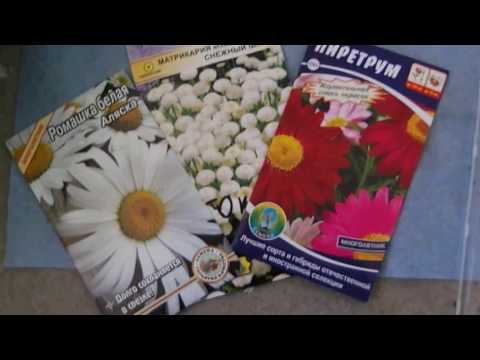

Watch this video on YouTube
Planting the matrix in the ground
What time to plant
Before proceeding with transplanting marticaria seedlings into open soil, it should be hardened. This procedure is carried out half a month before planting the plants in open ground, as a rule, this time falls on the first or second half of May. Seedlings can be transferred to the loggia and every day it should be ventilated, while the duration of such a procedure should be increased gradually. In the second half of May or early June, the bushes will be fully prepared for planting in open soil, which is carried out only after the threat of recurrent night frosts remains behind, and the ground warms up well and warm weather sets in.
Landing rules
To grow such a flower, you should choose a lighted open area with nutritious and well-drained soil. In general, the land on the site can be absolutely any, since marticaria grows everywhere, develops and reproduces by self-sowing very well. During planting, the plants are taken along with a lump of earth and placed in pre-prepared holes, the distance between which should be from 25 to 30 centimeters, thanks to which each bush will have a sufficient feeding area. As the bushes grow, branching will begin and, in the end, they will close. The planted plants must be well watered. After the liquid is absorbed into the soil, its surface will need to be covered with dry earth or compost. Transplanting seedlings tolerates very well.
Matricaria care in the garden
Even an inexperienced gardener can handle the cultivation of chamomile in your garden. The fact is that it is distinguished by its undemanding care and growing conditions. In order for the bushes to grow and develop within normal limits, they need to provide timely watering, weeding, feeding and loosening the soil surface. In order for the bushes to retain high decorativeness, you need to cut off the flowers that have begun to fade in time. When the bushes have faded, take a sharp, sterilized tool and remove any broken or dried stems. And if you want to grow chamomile on your site as a perennial, then before frosts come, you need to cut off the bushes completely, and then the site is covered with a layer of dry foliage, peat or sawdust, which is thrown on top of spruce branches.
How to water and feed properly
When watering such a crop, it must be remembered that it belongs to such plants that tolerate a short drought much easier than stagnant liquid in the root system. It is necessary to water the area systematically, especially during a long dry and hot period. Warm water is used for irrigation, and the procedure itself is carried out in the early morning or in the evening (not earlier than 16 hours).
The first time the bushes need to be fed after 15–20 days have passed from the moment they were planted in open soil. For this, you can use both organic matter and mineral complex fertilizers. Then the plants are fed regularly every 15–20 days. When the bushes have faded, fertilizers are stopped in the soil.
Matricaria pests and diseases
Such a plant is highly resistant to diseases and harmful insects. However, problems may arise with it.If it is grown in unfavorable conditions, then the likelihood of its defeat by diseases such as rust, gray rot, powdery mildew and fusarium increases. If a gray fluffy bloom is seen on the bushes, then they must be removed from the site as soon as possible and burned, since these plants are affected by gray rot, which is currently considered incurable. Healthy plants remaining on the site should be sprayed with a solution of a fungicidal preparation for prevention purposes. Other fungal diseases can be dealt with with a solution of Fundazol, Cuproxat, Oxychom, Topaz, or other drugs of a similar effect. In order for chamomile to recover completely, it will need at least 2-3 treatments.
Aphids, wireworms, star-winged flies and thrips can also harm marticaria. For prevention purposes, make sure that there is no weed on the site, it is pulled out immediately after it appears. In the event that you nevertheless found pests on the plants, then spraying with such insectoacaricidal agents as: Karbofos, Aktellik or Agraveritn will help to save them. These drugs are often used to combat arachnids and other harmful insects that have settled on both garden and indoor crops.
Also, marticaria can greatly harm the wireworm, which is the larva of the click beetle. It lives in soil and can severely injure the root system of shrubs. Often, such pests can be found in an area that is located near a field with potatoes. To get rid of it, it is recommended to make special traps. To do this, in different places on the site, not very deep pits are made, into which the bait is laid; as it is, you can use pieces of fresh beets, carrots or potatoes. From above, the trap should be covered with a piece of plywood, board or metal. After two or three days, check the trap; during this time, a fairly large amount of wireworm should slide down to the bait. Remove the vegetable pieces and burn them along with the pests, and you can put fresh bait in their place if necessary.
Types and varieties of matrix with photos and names
As a rule, the most popular among gardeners are such representatives of the Astrov family as: popovnik, nivyanik, aster and gerbera. However, some types of marticaria are also quite often chosen to decorate gardens and flower beds.
Chamomile (Matricaria recutita)
Or chamomile (Matricaria chamomilla), or peeled chamomile (Chamomilla recutila). This plant is a type species of the genus Marticaria. A not very tall bush has a weak specific aroma. Its root is tap and branched. Erect, highly branching single stem is hollow from the inside, it can reach a height of about 0.4 meters. Sedentary alternate leaf plates have a double pinnately dissected shape, and they include pointed narrow-linear slices. At the tops of the stems there are small single inflorescences-baskets, which include reed flowers of white color and tubular ones - yellow. Under natural conditions, such a flower prefers to grow on sandy soils. And in garden plots, it is planted along with wildflowers. Or you can choose a site for it, which will then be dug up.
Chamomile Chikhachev (Matricaria tchihatchewii)
This lush blooming look is very decorative. In nature, it can be found in Asia Minor. The height of the branched bushes can vary from 0.15 to 0.3 meters. On a leafless long peduncle, single inflorescences-baskets grow. Often this species is cultivated in rock gardens, or on rocky soils, where other crops grow very poorly.
Fragrant chamomile (Matricaria discoidea)
The homeland of this species is the Far East and North America. However, today it can be found in almost all countries, while such a flower grows like a weed.The height of a bush with a specific odor can vary from 0.1 to 0.3 m. In the upper part, the shoots branch strongly. The sedentary alternate leaves are doubly pinnately divided into pointed lobes of a flat linear shape. On short pedicels, small inflorescence baskets grow, which include only tubular flowers of a yellow-greenish color, they grow on short peduncles. This type is widely used for medicinal purposes, as well as for cosmetic purposes, for example, for dyeing hair.
Chamomile (Matricaria parthenium)
Either excellent matricaria (Matricaria eximia), or chrysanthemum parthenium (Chrysanthemum parthenium). This species is found in the wild in Europe. It is very similar to a small chrysanthemum thanks to its characteristic aroma and blade carved leaf plates. The plant forms compact bushes that branch very strongly, their height can reach about 0.4 m. A large number of inflorescences-baskets are formed on them, reaching about 25 mm in diameter. Their middle is yellow, and the shape of ligulate white flowers is oblong-rounded. The baskets are part of the thick scutes. Flowering begins in mid-summer and ends in late autumn. This species has a large number of varieties and garden forms:
- White Star... Simple inflorescences-baskets are painted white.
- Aureum... Large-lobed leaf plates have a golden color. Baskets have a yellow center and white marginal flowers.
- Golden Ball... The globular inflorescences of golden color contain only tubular flowers.
- Snow Globe (Snow Ball)... Short ligulate flowers are wide and white.
- Lemon Santana... The color of the baskets is light yellow.
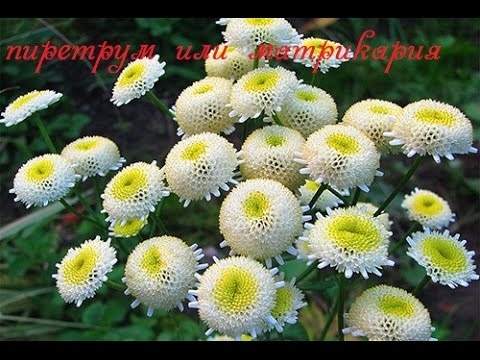

Watch this video on YouTube

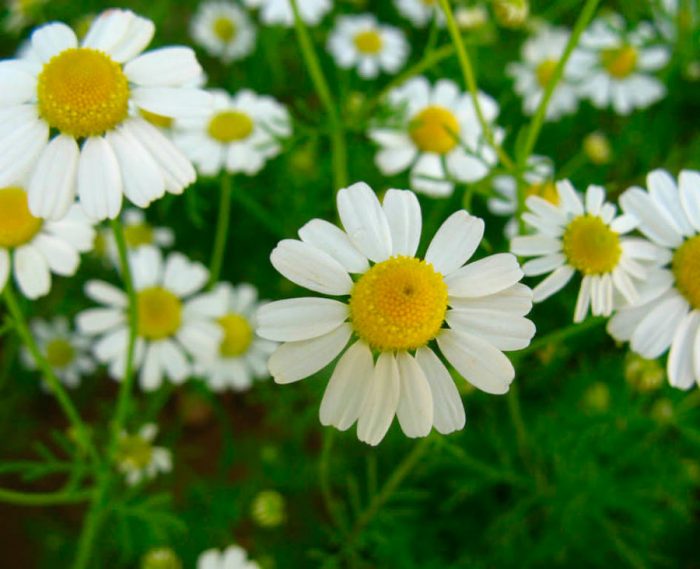
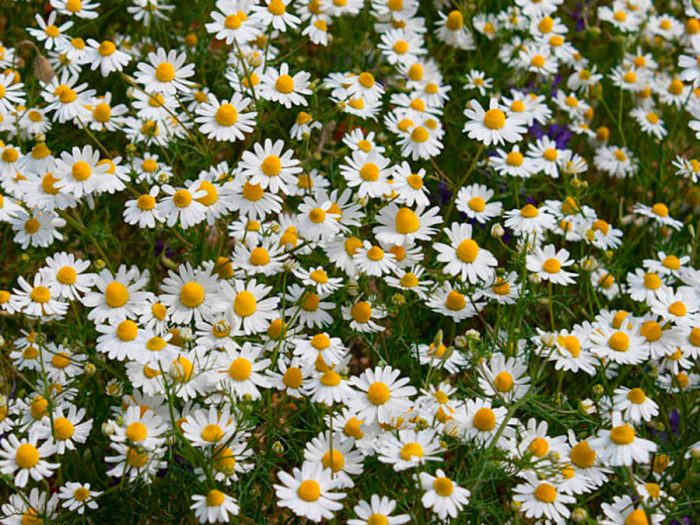
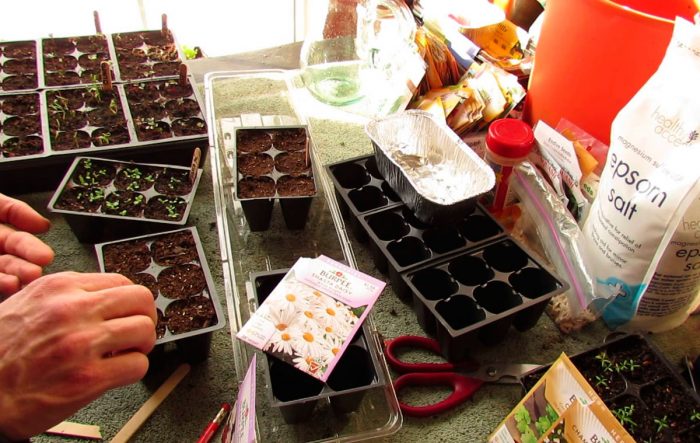

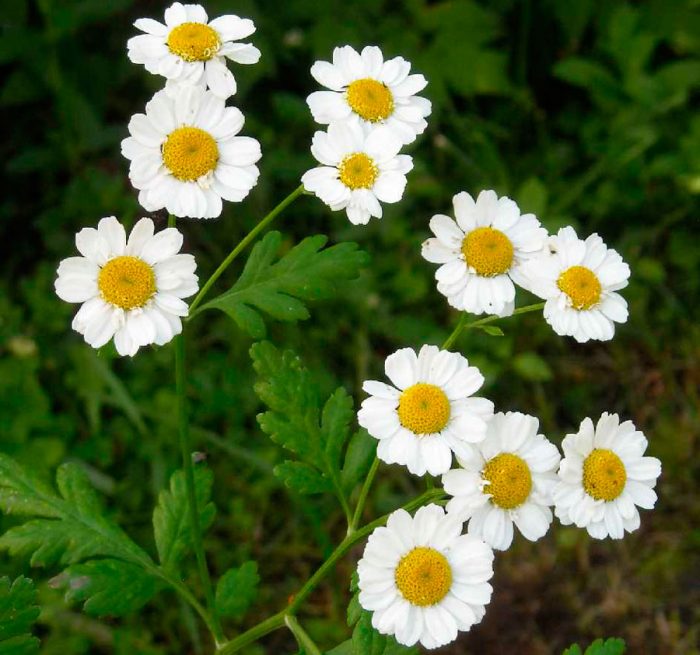
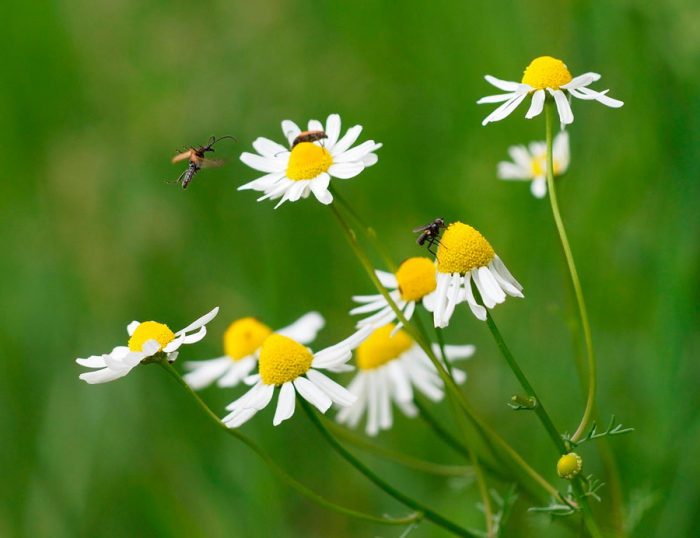
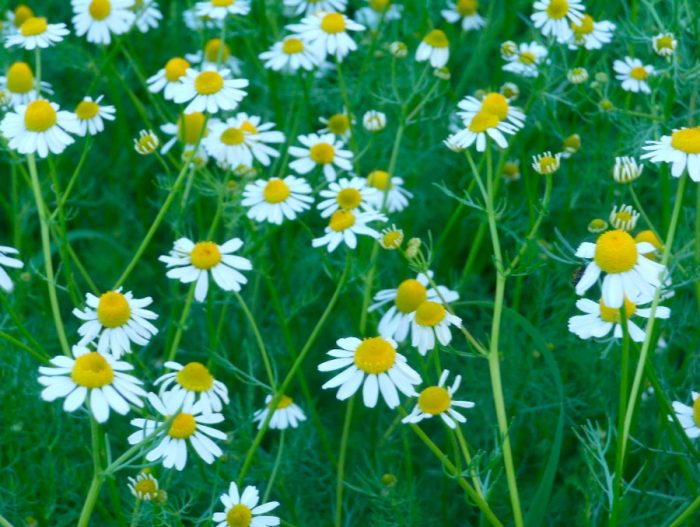
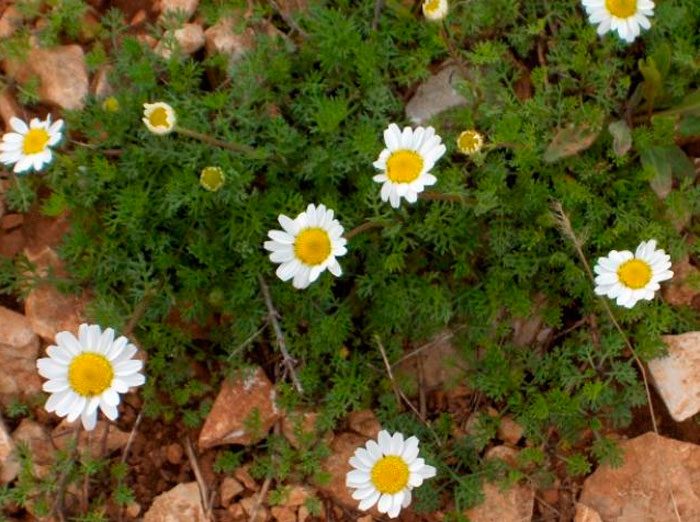
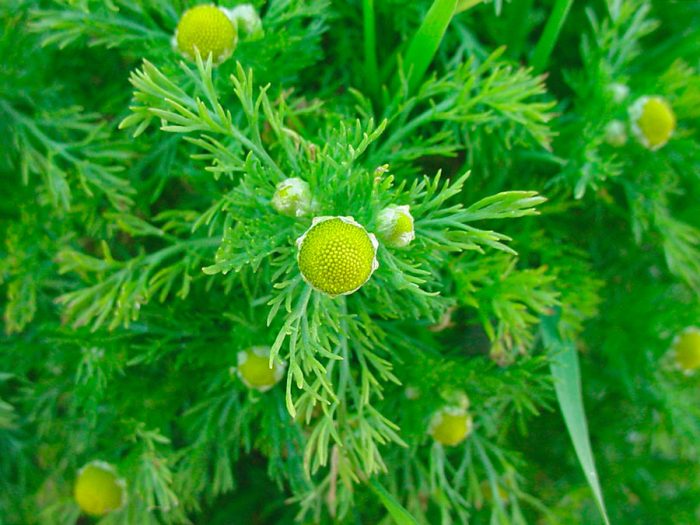
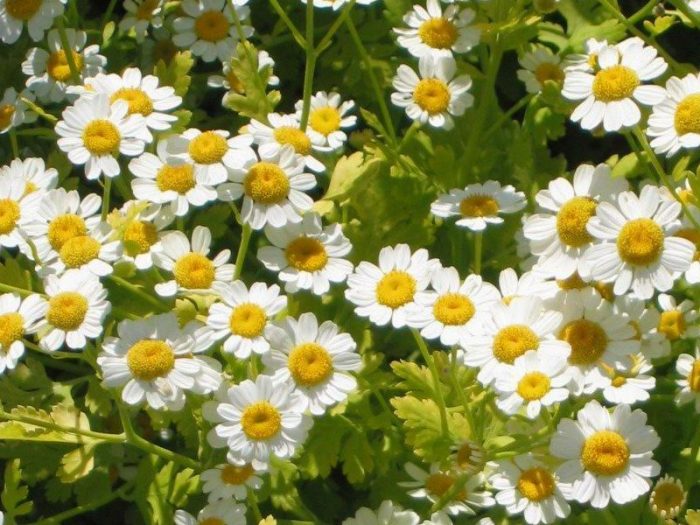

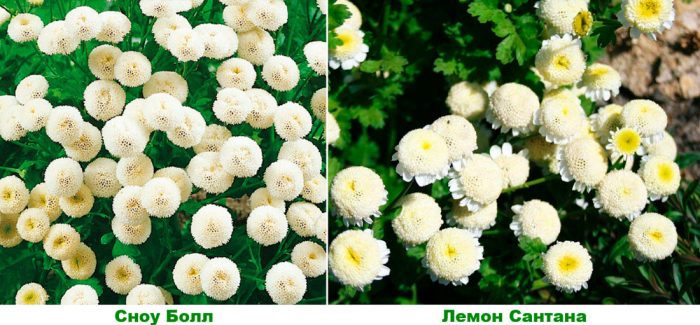










Matricaria flower prefers well-drained and fertilized soil in an open, sunny location. Chamomile has no special requirements for the composition of the soil: it can grow and multiply by self-seeding on any soil.